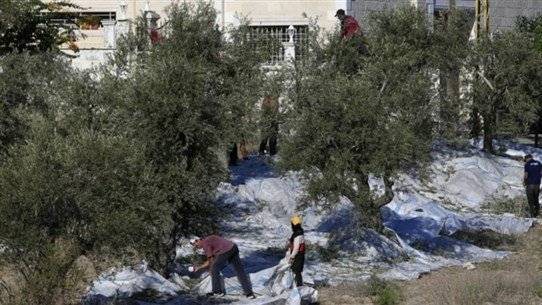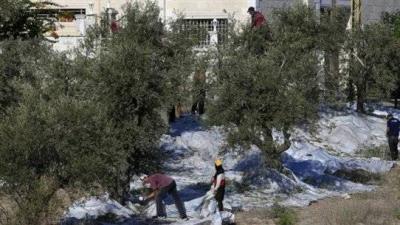Slowly, the olive harvest season has started in the south, as most olive tree owners awaited "the first rain" to irrigate their trees, which suffered from a lack of rainfall in April and a disruption of state water supply throughout the summer until now. Despite this, "the season is acceptable, and the olive trees are full of fruit," says Fatima Kashmar from the town of Rab' Thalathin, who decided to harvest her olives early after the fruits began falling to the ground due to a disease known as "peacock eye," which affected many trees.
This is not the first time the disease has struck olive trees, but according to Kashmar, "this year we were unable to combat it because the Ministry of Agriculture was completely absent, along with the medicines needed to fight diseases affecting olives. The pesticides available in the market are sold in hard currency, which we cannot afford." Kashmar, like many others in the region, did not hire workers for the olive harvest, as "the payment for workers has also become high, most of them demand 500,000 Lebanese pounds per day."
Ali Bou Taaam, who began harvesting his olives in the neighboring town of Taybeh, points to "the problem of heavy olive fruit drop, and the olive oil production is much lower than in previous years," attributing the reason to "the drought and the spread of the peacock eye disease." Bou Taaam notes that "a batch of olives produced about one and a half kilograms of oil, whereas in the past, it produced around three kilograms."
Salim Bazi, owner of a modern olive press in Bint Jbeil, confirms that "most farmers and olive tree owners are refraining from hiring workers today and are harvesting by themselves. While municipalities set the daily wage for workers at 400,000 pounds, workers have imposed a higher rate." Regarding the cost of processing olives at presses, "it constitutes 10% of the production because presses need to operate generators for long periods," considering that "the rising costs are shared by both farmers and press owners; even the price of an empty oil gallon has increased from 4,000 pounds to 120,000 pounds, causing the price of a canister of olive oil to reach 120 US dollars."
**Resistant Bacteria**
Fuad Wansa, head of the Ministry of Agriculture's center in Marjeyoun, believes that "farmers should forego hiring workers and use small olive harvesting machines, which range in price from 400 to 1,000 dollars, as they will help maintain the trees and their yield in the coming years, in addition to reducing harvesting costs." He called for municipalities or any public entity to purchase and invest in these machines "because they will create jobs for Lebanese workers, reduce harvesting costs, and contribute to improving production." Wansa, now a member of the National Committee for Olive Cultivation, is participating in a conference in Italy to train on combating the "resistant bacteria" that has affected more than a million olive trees in Italy and Spain, "and it is quite possible that it could spread to Lebanon," he says, confirming that "the Ministry of Agriculture has recently confirmed that the bacteria affecting olive trees in Europe exists in Lebanon in some plants, so urgent action is needed to combat it before it spreads to olive trees." He emphasized "the necessity for farmers to pay attention to how to prune trees, use traps for the flies that breed on them starting May 15 each year, and spray the trees immediately after harvesting and pruning with a substance called Genzaara to prevent the spread of the peacock eye disease, while also prohibiting workers from using sticks during harvesting."
**Creating Seedlings**
For his part, Selim Murad, head of Jihad al-Bina in the south, advises "creating special nurseries for olive trees to plant more than 25,000 seedlings annually, adopting the local olive variety (Sourani) for its importance in adapting to the climate and resisting diseases, developing specialized advisory programs on olive harvesting, processing, packaging, and storage, and seeking to establish foreign markets, especially in diaspora countries." He points out that "olive seedlings brought from Syria have good specifications, but they suffer from slow growth in our areas and cannot withstand diseases." According to a study prepared by Murad, there are 13.5 million olive trees in Lebanon, 45% of which are in the south, and 55% in the Koura and Akkar.




